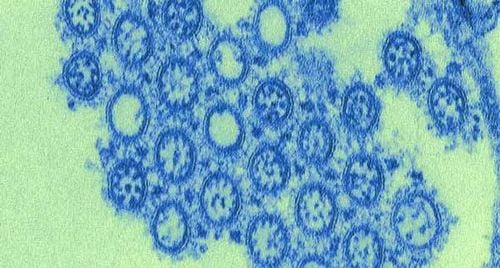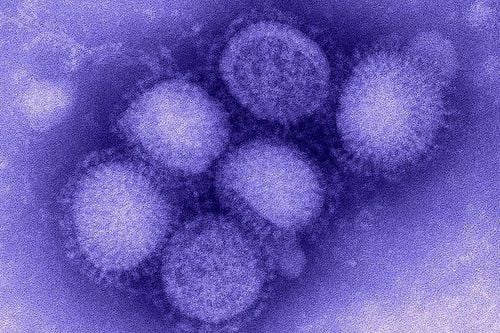This is an automatically translated article.
Influenza virus is the cause of the flu. This is an acute respiratory disease with a rapid spread and if not well controlled, it is easy to develop into an epidemic. Understanding how influenza viruses change can help improve disease prevention.
1. Influenza viruses
There are four types of influenza viruses, including: A, B, C, and D. Human influenza A and B viruses cause seasonal epidemics (known as seasonal flu) that occur almost every winter in the United States. . Influenza A virus is the only influenza virus known to cause pandemic influenza, the global epidemic of influenza. A pandemic can occur when a new strain of influenza A virus emerges. Viruses are capable of causing disease in humans and can easily spread into epidemics in the community. Infection with type C influenza virus usually causes mild illness and does not cause outbreaks of influenza in humans. Influenza D virus mainly affects livestock and is not known to infect or cause illness in humans.
Influenza A viruses are divided into subtypes based on two proteins on the surface of the virus: hemagglutinin (H) and neuraminidase (N). There are 18 different hemagglutinin subtypes and 11 different neuraminidase subtypes (H1 to H18 and N1 to N11). Although there are approximately 198 different combinations of influenza A subtypes, only 131 have been detected in the wild. The influenza A viruses currently circulating regularly in humans include: A (H1N1) and A(H3N2). Influenza viruses can be further subdivided into different genetic clades in different clades.
Currently, circulating influenza A (H1N1) viruses are related to influenza viruses that emerged in the 2009 pandemic, in the spring of 2009 and caused the influenza pandemic. This virus, scientifically known as pdm09(A) virus, commonly known as the 2009 virus, has continued to circulate seasonally since then. These H1N1 viruses have undergone relatively small genetic alterations and alterations in their antigenic properties (that is, the viral properties that affect immunity) over time.

Virus cúm A (H1N1) có nguồn gốc từ virus cúm xuất hiện ở đại dịch năm 2009
Of all the influenza viruses that frequently circulate and cause disease in humans, influenza A (H3N2) viruses tend to change more rapidly, both genetically and antigenically. Influenza A (H3N2) viruses have formed many distinct, genetically different strains in recent years and continue to circulate.
Influenza B viruses are not divided into subtypes, but are instead classified into two lineages: B/Yamagata and B/Victoria. Similar to influenza A viruses, influenza B viruses can then be classified into specific clades and subtypes. Influenza B viruses generally change more slowly in genetic and antigenic characteristics than influenza A viruses, especially influenza A (H3N2) viruses. Influenza surveillance data from recent years indicate co-infection of influenza B virus from both strains in the United States and worldwide. However, the prevalence of influenza B virus from each circulating strain can vary by geographic location.
2. Signs of the flu
You may have the flu if you have some of the following symptoms:
Fever Cough Sore throat Runny nose Congested nose Chills Body aches Headache Fatigue Nausea, vomiting Diarrhea ...

Sau khi virus xâm nhập vào cơ thể vài ngày người bệnh mới biểu hiện các triệu chứng
After the flu virus enters the body, flu symptoms usually appear about 2 days (some other cases will appear about 3 to 4 days). Before you know you are sick, you have the ability to pass the disease on to others. In addition, some people have the flu virus but have no symptoms.
Influenza virus spreads disease through airborne droplets at breakneck speed. This virus can be spread up to nearly 2m when an infected person sneezes or coughs. You can also become infected if you accidentally breathe in droplets containing the flu virus or if they get into your mouth, nose, or eyes. If you touch an object where those droplets fall, you can also get the flu, such as doorknobs, personal items....The flu virus can stay on hard surfaces for up to 48 hours. .
3. How can the flu virus change?
3.1 Antigenic drift Antigenic drift is one of the ways the influenza virus changes. These are small changes (or mutations) in the genes of the influenza virus that can lead to changes in the surface proteins of the virus: HA (hemagglutinin) and NA (neuraminidase). The influenza virus HA and NA surface proteins are antigenic, which means that they are recognized by the immune system and are capable of triggering an immune response, including the production of antibodies that can stave off infection. Changes associated with antigenic variation occur continuously over time as the virus replicates. Most flu shots are designed to target the HA surface antigens/proteins of the influenza virus. The nasal spray flu vaccine (LAIV) targets both the HA and NA of the influenza virus.

Sử dụng các biến thể kháng nguyên để thay đổi gen của virus cúm
Small changes that result from antigenic drift often give rise to closely related viruses. Closely related influenza viruses often have similar antigenic properties. This means that the antibodies your immune system makes against an influenza virus will be able to recognize and respond to antigenically similar influenza viruses (this is called protection). cross).
However, small changes associated with antigenic variation can accumulate over time and lead to antigenically different viruses. It is also possible that a small change in a particularly important site on the BP leads to antigenic variation. When the antigen mutates, the body's immune system may not recognize and prevent illness caused by the newer influenza virus. Thus, a person becomes susceptible to influenza infection again, because antigenic variation has changed the virus enough that a person's existing antibodies will not recognize and neutralize the newer influenza viruses.
Antigenic variation is the main reason people can get the flu more than once, and it's also the main reason why the flu vaccine composition must be reviewed and updated each year (as needed) to keep up with the evolution and change of influenza virus.
2.2 Antigenic Shift Another type of antigenic change is called an antigenic shift. An antigenic transposition is an abrupt change, occurring mainly with influenza A viruses, that results in novel HA and/or novel HA and NA proteins in infectious human influenza viruses. The change could lead to a new type of influenza A in humans. A possible change is when influenza viruses from animal populations are able to infect humans. Such viruses of animal origin may contain a different HA or HA/NA combination with the same subtype in humans that most people do not have immunity to the new virus. Influenza virus change occurred in the spring of 2009, when an influenza virus with genes from North American pigs, Eurasian pigs, infected humans and rapidly spread in the community, causing a pandemic. When antigenic transposition occurs, most people have little or no immunity against the new virus.
While influenza viruses change continuously due to antigenic variation, antigenic permutations are less frequent. Pandemic influenza is very rare; There have been four pandemics in the last 100 years. Type A viruses undergo both antigenic variation and permutations and are the only influenza viruses known to cause pandemics, while influenza B viruses change only through a gradual process of antigenic variation.

Hoán vị kháng nguyên chủ yếu xảy ra ở virus cúm A
Influenza vaccination can protect against influenza virus like the one used to make the vaccine. The seasonal flu vaccine does not protect against influenza C or D viruses. Additionally, the flu vaccine will NOT protect against infection and illness from other viruses that can also cause flu-like symptoms. . There are many viruses other than the flu that can lead to flu-like illness (ILI) that is spread during flu season.
Based on the recommendations of the US Centers for Disease Control and Prevention (U.S. CDC), Vinmec International General Hospital has implemented influenza vaccination in the entire hospital system across the country. for all customers 6 months and older.
Customers who choose to get vaccinated at Vinmec will be completely assured of the quality of the vaccine as well as the implementation process, because:
Children will be examined and screened by pediatricians - vaccines. Full screening of health and fitness problems, advice on preventive vaccines and injection regimens, how to monitor and care for children after vaccination before ordering vaccination according to the latest recommendations of the Ministry of Health & World Health Organization to ensure the best effectiveness and safety for children. A team of experienced and professional pediatric doctors and nurses, understand children's psychology and apply effective pain relief methods for children during the vaccination process. 100% of vaccinated children were monitored for 30 minutes after vaccination and reassessed before leaving. Underwent general supervision before, during and after vaccination at Vinmec Health System and always have an emergency team ready to coordinate with the vaccination department to handle cases of anaphylaxis, respiratory failure - circulatory arrest, ensuring Ensure timely and correct handling when incidents occur. The vaccination room is airy, with a play area, helping children feel comfortable as if they are walking and have a good mentality before and after vaccination. Vaccines are imported and stored in a modern cold storage system, with a cold chain that meets GSP standards, keeping vaccines in the best conditions to ensure quality. Parents will receive a reminder message before the vaccination date and their child's vaccination information will be synchronized with the national immunization information system. Vinmec International General Hospital is currently providing a Package Immunization Program with a variety of vaccines for different audiences, from infants, young children, adults, and women before and during pregnancy pregnant.
If you have a need for consultation and examination at Vinmec Hospitals under the nationwide health system, please book an appointment on the website for service.
Please dial HOTLINE for more information or register for an appointment HERE. Download MyVinmec app to make appointments faster and to manage your bookings easily.
References: cdc.gov













